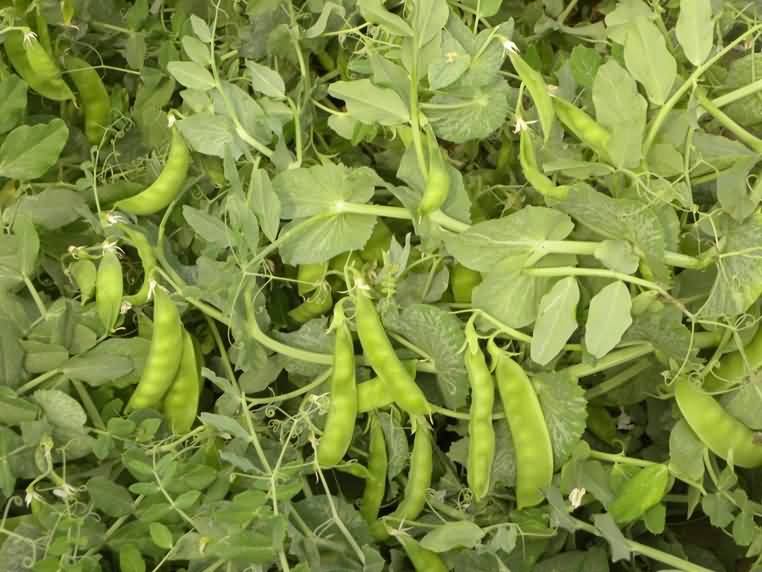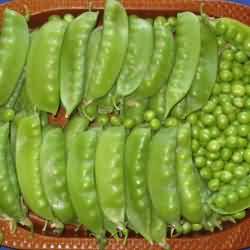स्नो मटर या स्नैप मटर का पोषण और स्वास्थ्य महत्व
Pea also known as the “queen” of pulses has been grown and consumed since more than 8000 years. The garden or field pea is cultivated worldwide since millennium because of the lower levels of toxins found in the seed (Liener, 1982) and apart from toxins the pea is also known as a protein rich crop having relative protein content estimated to be 25% (Monti 1983).
Garden peas (P. sativum var. sativum) are generally utilized for human consumption, field peas (P. sativum var. arvense (L.) Poiret) are widely utilized in livestock and traditionally as green manure. The immature pods are also consumed as vegetable in another types of peas known as sugar snap peas or snow peas.
Peas are generally categorized into two types the grain legume types and the vegetable types. The grain legumes category consists of field or dry peas whereas the vegetable types of which the pods as well as seeds both are consumed consists of garden pea, snow pea or Chinese pea and the snap pea.
The peas with edible pods are classified into two classes viz. the Snow or Chinese pea and the Snap pea. The snap peas differ from snow peas in aspects like thick pod walls that are tightly developed around the seed which turn round at maturity. The seeds as well as pods are consumed when they are developed similar to garden pea.
The snap pea cultivars have white colored flowers with wrinkled and green cotyledons present in seeds. On the other hand, the snow peas have white or purple flowers, smooth or wrinkled seeds and thin pods which lack fiber. Snow peas are said to be derived from garden peas as well as field peas as visible from their varietal traits. (Vilmorin, 1885; Hedrick 1928).


The snap pea belongs to the same species as of garden and field pea having pods that are edible. These pods differ from those of garden peas as they lack fiber. Snap pea popular as a vegetable crop has been cultivated since the 19th century. Snap peas are also known as “Sugar snap” peas as the term “snap pea” originated from the release of Gallatin Valley Seed Company’s first commercial cultivars which was named “Sugar snap”.
The present-day sugar snap pea is an offspring of a cross between a snow pea and an unusual pea which has thick walls and tight pods. On the other hand the snow pea (Pisum sativum var. macrocarpon) is a unique botanical cultivar or subspecies of Pisum sativum. The pods are consumed before the string develops and the peas start to swell.
The different pod and seed characteristics differentiating the various pea classes are described in the Table 1 below: -
Table 1 Essential pod and seed characteristics of pea classes
|
Type |
Cotyledon |
Pod |
Parts Consumed |
Plant Height |
||||
|
Color |
Shape |
Parchment |
Wall Thickness |
|||||
|
Dry or Field Pea |
Yellow or green |
Smooth |
Present |
Thin |
Mature seeds |
Mostly tall |
||
|
Shell or Garden pea |
Green |
Mostly wrinkled, some smooth |
Present |
Thin |
Immature seeds |
Mostly short |
||
|
Chinese or Snow |
Green |
Smooth or wrinkled |
Absent |
Thin |
Very young pods & seeds |
Tall and short |
||
|
Snap |
Green |
Wrinkled |
Absent |
Thick |
Immature pods & seeds |
Mostly short |
||
Production and Consumption of Snow Peas
According to the recent second advance estimates of 2021-22, in India the total area under pea cultivation is 582 thousand hectares giving a production of 6076 thousand million tonnes. Snow peas are not widely grown in India, however its popular in countries like USA, European countries, China, Japan and in South East Asian countries.
Snow peas are predicted to have a massive scope for its production especially in the urban areas apart from being an excellent processed vegetable which provide huge export returns. Snow peas can be consumed as raw or in salads, slightly boiled, steamed or eaten as stir fried or in other dishes.
Nutritional Importance of Snow Peas
Snow peas are harvested prior to reaching full maturity. Both the edible podded peas viz. the sugar and the snap peas are identical in their nutritional profile. As compared to the original shelled pea both of them contain less amount of carbohydrates. The nutrition profile of 100 g of snow peas is described in Table 2.
These edible podded peas have high nutraceutical importance and are highly preferred as salads. It is a good source of vitamin “A”, “B6”, “C”, iron, potassium, dietary fiber, magnesium and little amount of good fats. These snow peas are highly recommended for weight loss, reduce constipation, building the immune system and maintaining heart health. Snow peas also contain good number of antioxidants ranging from 43 to 71.6 mg /100g. (Pandey et al., 2020).
In a study the total phenolic, ascorbic acid and β carotene content in snow pea was significantly higher than any other vegetables. (Ismail et al. 2009) The phenolic compounds like vanillic, caffeic, p-coumaric, ferulic and sinapic acids, quercetin and kaempherol are responsible for the antioxidant and anti-radical properties found in pea seeds. (Amarowicz and Troszynska, 2003).
Snow peas contain a considerable amount of potassium and vitamin C which helps the heart in various ways. Due to the presence of good amount of antioxidants it protects the retina of the eye from oxidative stress which leads to a slowdown in the development of cataracts.
These edible podded peas also contain vitamin K which strengthens bones and prevents osteoporosis. Another important health benefit of snow pea consumption is that it is capable of destroying clots and bad cholesterol in the blood vessels in the same way it can break and dissolve kidney stones.
Apart from physical health benefits there are some mental health benefits also due to the presence of magnesium in Snow peas. Magnesium plays a key role in protecting someone from depression. Therefore, regular consumption of snow pea is quite helpful for preventing depression.
Table 2 Nutritional Profile of 100 grams of Snowpea
|
Nutritional Component |
Content (% DV) |
|
Calories |
42 |
|
Carbohydrates |
7.5 grams |
|
Fiber |
2.6 grams |
|
Protein |
2.8 grams |
|
Vitamin A |
22% |
|
Vitamin C |
100% |
|
Vitamin K |
31% |
|
Folate |
10% |
|
Magnesium |
6% |
|
Phosphorus |
5% |
|
Potassium |
6% |
|
Manganese |
12% |
Production technology of Snow peas
Climate and Soil
It is a cool season crop. It produces best yields in the cool season as it is sensitive to heat. The optimum temperature for germination is 22̊ C. Temperature above 30̊C restricts pollination and causes early maturity. The minimum soil temperature should be 10̊C.
Cultivation
Snow peas are grown in the subtropical regions of India in the month of October- November. In the hilly areas it is taken as an off-season crop where it is sown during March- June as a summer crop.
Seed rate and Seed Treatment
A seed rate of 90-100kg is sufficient for 1 ha. The seeds are sown with a spacing of 45-60 cm between the rows and 7.5-10 cm between the plants. Treating the seeds with Rhizobium helps in increasing nodulation which improves nitrogen fixation capacity of the crop.
Manuring and Fertilizer
FYM at 10-20 tonnes /ha is applied at the time of sowing, 20-50 kg of nitrogen. 30-60 kg phosphorus and 30-60 kg potassium per ha is recommended for good yield. Top dressing with nitrogen at 10 kg/ha after the first picking is required.
Irrigation
Snow peas are very sensitive to drought and waterlogging. Therefore, it is recommended to give pre sowing irrigation for proper germination. The critical stages for irrigation are flowering and pod formation to ensure good quality pods and high yield.
Interculture operations
First hoeing and earthing up is done after 2-3 weeks of sowing and second during flower initiation. Weed control is an essential inter culture operation because the crop growth is slow during early stages. Applications of Pre-emergence herbicide Alachlor @ 3 litre/ha or pendimethalin @3 litre/ha or fluchloralin @2.5 litre /ha is recommended for weed control.
Some common varieties of Snow peas
As mentioned above India there is not much emphasis of Snow peas in particular but few varieties are popular such as Arka Apoorva, Arka Sampoorna, Mithi Phalli, Sylvia etc.
Some key traits are described below-
1. Mithi Phalli-An introduction of edible podded pea released from PAU, Ludhiana. Pods are light green with a length of 12-13 cm. Yield potential is up to 10-11 tonnes/ha.
2. Sylvia- It is an introduced variety from Sweden. Pods are yellowish in colour lack parchment layer with sweet pods.
3. Arka Apoorva- Midseason variety released from IIHR Bangalore, consists of crisp, long pods with yield potential up to 10-11 tonnes/ha. Resistant to powdery mildew.
4. Arka Sampoorna-Mid-season and Whole pod edible pea variety. Pods are medium long, light green coloured. Seeds are medium bold, light green and sweet. Resistant to rust and powdery mildew. Developed by Pedigree method of selection from F7 generation involving(Bonneville X IIHR 209) X Freezer 656 X Oregon Sugar). Pod Yield: 8.0 t/ha in 90 days.
Source: https://www.iihr.res.in/garden-pea-arka-sampoorna
Harvesting and Post-Harvest Management
Harvesting starts at 8-12 weeks after sowing and prolongs till 8-10 weeks. The correct stage to harvest the pods is when the pods are still flat and seed establishment has just begun. The pod length and width during harvesting is 7.5 -10 cm and 2.5 cm respectively. T
he estimated yield of snow peas ranges from 2-7 tonnes/ha. Snow peas are stored at 0-2̊ C with 90-95% relative humidity. The pods of Snow peas are stored in films of Polymethyl pentene at a temperature of 5̊C and a concentration of oxygen and carbon dioxide of 5kPa to increase the shelf life, internal and external traits of pods.
Conclusion
Therefore it can be concluded that having so many nutritional aspects, the edible podded classes of pea need to be more studied and researched upon as they are very underrated and less understood.
These snow peas can be treated as an alternative source of nutrition for people dealing with issues like obesity, osteoporosis, anaemia, cataracts, depression and many other health illnesses.
Due to the less popularity of snow peas in India not many farmers are aware of this crop. These snow peas take very less time to prepare and as seen above are a good source of essential nutrients. Looking into its enormous benefits this crops exhibits itself as a rising crop for the future generation.
Authors
Brij Bihari Sharma*, Jhilick Banerjee and Vinod Kumar Sharma
Division of Vegetable Science, ICAR- Indian Agricultural Research Institute, New Delhi-10012
Division of Germplasm Evaluation, ICAR- NBPGR New Delhi
*Corresponding Author’s email:
